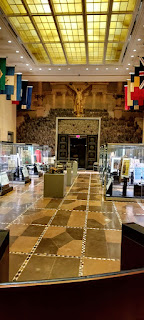When I saw a news announcement about the Beatrix Potter: Drawn to Nature exhibit at the Morgan Library & Museum in Manhattan, I knew it would be worth the plane ticket to take my mother for her birthday on my last free weekend in May. My maternal grandmother--from whom I got my middle name--was a children's librarian, and my maternal grandfather was a Shakespeare scholar, so we all grew up with a lot of British literature, including Potter's delightfully illustrated little books about Tom Kitten, Mr. Jeremy Fisher (frog), and Mopsy, Flopsy, and Cottontail (bunnies).
My Awesome Parents (MAP) drove up with my aunt to their brother and his wife's house in northern New Jersey on Saturday morning. We lunched on their back deck, watched my cousin's son play a little baseball in a Memorial Weekend tournament, played Trekking the National Parks, and chowed down on ribs.
Sunday morning MAP, Aunt B, and I took the NJ Transit train into Penn Station and then walked to the museum in time to join the queue at opening. We had wisely purchased tickets the day before and quickly got into the gallery. One room was dedicated to Potter's childhood in a wealthy London family who were also artistically inclined. She wasn't allowed to go to school like her younger brother, so she visited local museums with her governess, sketched in local parks, and practiced watercolors.
Potter developed into an extremely talented artist. She had a particular fascination with mushrooms and fungi, and she preferred the Lake District to London.
When she wrote letters, especially to children, she would add little drawings about the things she talked about, and sometimes she imagined little stories about her pets or wild animals.






















































